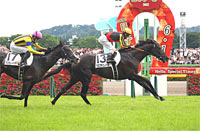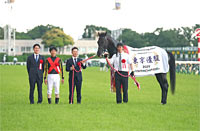Tokyo Yushun (Japanese Derby) (G1) - Data Analysis
Ultimate contest for a generation of runners that has produced plenty of drama
We are rapidly approaching the Tokyo Yushun (Japanese Derby), also known as the “Festival of Racing” in Japan. In 2020, Contrail secured his second Triple Crown victory in the race, and went on to become the undefeated Triple Crown winner. In 2021, Shahryar achieved the victory in the race after abstaining from the Satsuki Sho (Japanese 2000 Guineas), while Do Deuce and Tastiera both bounced back from a defeat in the Satsuki Sho to win the race in 2022 and 2023, respectively. The question this year is whether we should focus on runners who ran the Satsuki Sho, or those entering the race via another route. Let’s now analyze some trends in this race based on results over the last 10 years.
Highly favored runners have the edge
Many of the runners backed as race favorite have historically won the Satsuki Sho. Over the last 10 years, runners in this group have delivered performance of [2-3-1-1], a strong showing befitting winners of the first Triple Crown race. Among runners backed as 2nd and 3rd favorites, the majority turned in strong performances, so this suggests highly favored runners fare well in this race. In particular, 19 of the 20 Top 2 finishers were backed as 5th favorite or higher. However, among third-place finishers, six runners were backed as 6th favorite or lower, with three of these backed as 10th favorite or lower. In 2018, Cosmic Force finished third while backed as 16th favorite in a major upset that triggered a Trifecta payout of 2,856,300 yen. Keeping this example in mind, it may be interesting to place a bet with a runner backed by low favoritism. [Table 1]
[Table 1] Performance by favoritism (last 10 years)
| Favoritism |
Performance
[1st-2nd-3rd-4th or lower] |
Win ratio |
Top 2 ratio |
Top 3 ratio |
| 1st favorite |
2-3-2-3 |
20.0% |
50.0% |
70.0% |
| 2nd favorite |
1-3-1-5 |
10.0% |
40.0% |
50.0% |
| 3rd favorite |
3-2-1-4 |
30.0% |
50.0% |
60.0% |
| 4th favorite |
2-1-0-7 |
20.0% |
30.0% |
30.0% |
| 5th favorite |
1-1-0-8 |
10.0% |
20.0% |
20.0% |
| 6th-9th favorite |
0-0-3-37 |
0% |
0% |
7.5% |
| 10th favorite or lower |
1-0-3-84 |
1.1% |
1.1% |
4.5% |
Bulk of strong performers come from the Satsuki Sho
Of the 30 Top 3 finishers over the last 10 years, 23 came from the Satsuki Sho, the first leg of the Triple Crown races. Runners who enjoy success in the Satsuki Sho tend to have a strong presence in this top contest for the current generation of runners, as exemplified by Tastiera, who won the 2023 Japanese Derby after finishing 2nd in the Satsuki Sho. In addition, while Wagnerian secured the victory in 2018 after coming in 7th in the Satsuki Sho, we find no examples of strong performance among runners who had finished 10th or lower in the Satsuki Sho. [Table 2]
[Table 2] Among runners that had contested the Satsuki Sho in their previous race, performance by finish in the previous race (last 10 years)
| Finish in previous race |
Performance
[1st-2nd-3rd-4th or lower] |
Win ratio |
Top 2 ratio |
Top 3 ratio |
| 1st |
2-4-1-3 |
20.0% |
60.0% |
70.0% |
| 2nd |
2-2-1-5 |
20.0% |
40.0% |
50.0% |
| 3rd |
1-2-1-5 |
11.1% |
33.3% |
44.4% |
| 4th |
1-0-0-7 |
12.5% |
12.5% |
12.5% |
| 5th |
1-0-1-6 |
12.5% |
12.5% |
25.0% |
| 6th-9th |
1-1-2-20 |
4.2% |
8.3% |
16.7% |
| 10th or lower |
0-0-0-24 |
0% |
0% |
0% |
Among runners coming from a race other than the Satsuki Sho, a Top 2 finish in the previous race is a requirement, and runners that have been beaten to 3rd or lower have virtually no chance. In addition, runners who contested their previous race as 3rd favorite or lower also struggled, so when choosing from runners who enter the race via a different route than the Satsuki Sho, we should narrow down our selection to runners who finished in the Top 2 of their previous race while backed as 2nd favorite or higher. [Table 3]
[Table 3] Among runners that had contested a race other than the Satsuki Sho in their previous race, performance by favoritism and finish in the previous race (last 10 years)
| Favoritism and finish in previous race |
Performance
[1st-2nd-3rd-4th or lower] |
Win ratio |
Top 2 ratio |
Top 3 ratio |
| 2nd favorite or higher with Top 2 finish |
2-1-3-25 |
6.5% |
9.7% |
19.4% |
| Other than the above |
0-0-1-53 |
0% |
0% |
1.9% |
Note: Runners that had contested their previous race overseas are included in “Other than the above.”
Expect little from runners with experience of winning a 2,200m+ turf race
Looking at the 30 Top 3 finishers over the last 10 years in terms of race record by distance, we find that 20 had notched their longest-distance win in a turf race over 2,000m. Meanwhile, runners who have secured their longest-distance win in a turf race over 1,800m in recent years should not be underestimated, as this group includes 2021 winner Shahryar and 2022 winner Do Deuce. Conversely, runners with experience of winning a 2,200m+ turf race have produced zero winners and achieved a Top 3 ratio of only 6.1%. We should therefore keep in mind that strong performance in longer races is not an indicator of success. [Table 4]
[Table 4] Performance by longest-distance race in which runners secured the victory (last 10 years)
| Longest distance |
Performance
[1st-2nd-3rd-4th or lower] |
Win ratio |
Top 2 ratio |
Top 3 ratio |
| 2,200m+ turf |
0-1-1-31 |
0% |
3.0% |
6.1% |
| 2,000m turf |
8-6-6-61 |
9.9% |
17.3% |
24.7% |
| 1,800m turf |
2-2-2-39 |
4.4% |
8.9% |
13.3% |
| 1,600m or below |
0-1-1-15 |
0% |
5.9% |
11.8% |
| No victory in turf race |
0-0-0-2 |
0% |
0% |
0% |
Total career starts is a decisive factor
Shahryar, who won the race in 2021, rose to the top of his generation in his 4th race. For both Equinox and Sol Oriens who finished 2nd in the last two years, the Japanese Derby was their 3rd race. The total career starts for successful runners has trended down since around 2016, and all Top 2 finishers since that year have had 5 or fewer career starts. Runners that had contested 6 or more races have struggled with a Top 3 ratio of 3.8% over the last eight years. We should therefore focus on runners with 3 to 5 career starts when making our predictions. [Table 5]
[Table 5] Performance by total career starts (last eight years)
| Total career starts |
Performance
[1st-2nd-3rd-4th or lower] |
Win ratio |
Top 2 ratio |
Top 3 ratio |
| 5 or fewer |
8-8-6-69 |
8.8% |
17.6% |
24.2% |
| 6 or more |
0-0-2-50 |
0% |
0% |
3.8% |
Seek out the winner!
Watch Tokyo Yushun finish of sire
Among the last 10 winners, those from 2015 to 2021 were all colts sired by former Derby winners. In addition, 2014 winner One and Only and 2022 winner Do Deuce were both sired by Heart’s Cry, who was beaten to 2nd place in the Japanese Derby in 2004. Meanwhile, 2023 winner Tastiera was sired by Satono Crown, who was beaten to 3rd place in the 2015 Japanese Derby. Regardless of which of these two historical patterns applies (crop sired by Derby winner, or crop avenging the defeat of their sire), we can conclude that the offspring of sires who have chased the top places in the Tokyo Yushun have an edge in the race. [Table 6]
[Table 6] Finish of winners’ sires in the Japanese Derby (last 10 years)
| Year |
Winner |
Sire (finish in Japanese Derby) |
| 2014 |
One and Only |
Heart’s Cry (2nd) |
| 2015 |
Duramente |
King Kamehameha (1st) |
| 2016 |
Makahiki |
Deep Impact (1st) |
| 2017 |
Rey de Oro |
King Kamehameha (1st) |
| 2018 |
Wagnerian |
Deep Impact (1st) |
| 2019 |
Roger Barows |
Deep Impact (1st) |
| 2020 |
Contrail |
Deep Impact (1st) |
| 2021 |
Shahryar |
Deep Impact (1st) |
| 2022 |
Do Deuce |
Heart’s Cry (2nd) |
| 2023 |
Tastiera |
Satono Crown (3rd) |
(Maya Takanami)
|

- Preview
- Barrier draw
- Past performances of runners

- News
- Race result
- Video
- 2025 English

- 2024 English

- 2023 English

- 2022 English

- 2021 English

- 2020 English

- 2019 English

- 2018 English

- 2017 English

- 2016 English

- 2015 English

- 2014 English

- 2013 English

- Photo Gallery
2025 Winner: Croix du Nord


2024 Winner: Danon Decile


|




















